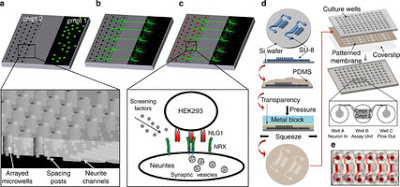MIT – Each of the brain’s 100 billion neurons forms thousands of connections with other neurons. These connections, known as synapses, allow cells to rapidly share information, coordinate their activities, and achieve learning and memory. Breakdowns in those connections have been linked to neurological disorders including autism and Alzheimer’s disease, as well as decline of memory during normal aging. Many scientists believe that strengthening synaptic connections could offer a way to treat those diseases, as well as age-related decline in brain function. To that end, a team of MIT researchers has developed a new way to grow synapses between cells in a laboratory dish, under very controlled conditions that enable rapid, large-scale screens for potential new drugs.
Schematic of the synapse microarray technology.
Synaptic function is affected in many brain diseases and disorders. Technologies for large-scale synapse assays can facilitate identification of drug leads. Here we report a ‘synapse microarray’ technology that enables ultra-sensitive, high-throughput and quantitative screening of synaptogenesis. Our platform enables the induction of synaptic structures in regular arrays by precise positioning of non-neuronal cells expressing synaptic proteins, while allowing neurites to grow freely around these cells. The technology increases by tenfold the sensitivity of the traditional assays, and simultaneously decreases the time required to capture synaptogenic events by an order of magnitude. It is readily incorporated into multiwell formats compatible with industrial high-throughput screening platforms. Using this technology, we screened a chemical library, and identified novel histone deacetylase (HDAC) inhibitors that improve neuroligin-1-induced synaptogenesis by modulating class-I HDACs. We also found a structure–activity relationship for designing novel potent histone deacetylase inhibitors, which can be applied towards development of new therapeutics.
In the new setup devised by Yanik and his colleagues, presynaptic neurons (those that send messages across a synapse) are grown in individual compartments on a lab dish. The compartments have only one opening, into a tiny channel that leads to another compartment. The presynaptic neuron sends its long axon through the channel into the other compartment, where it can form synaptic connections with cells arranged in a grid. “That way we can induce synapses in very well-defined positions,” Yanik says.
Using this technique, the researchers can create hundreds of thousands of synapses on a single lab dish, then use them to test the effects of potential drug compounds. This technique can detect changes in synaptic strength with 10 times more sensitivity than existing methods.
In this study, the researchers created and tested variants of a type of molecule known as an HDAC inhibitor. HDACs are enzymes that control how tightly DNA is wound inside the cell nucleus, which determines which genes can be copied and expressed. HDAC inhibitors, which loosen DNA coils and reveal genes that had been turned off, are now being pursued as potential treatments for Alzheimer’s and other neurodegenerative diseases.
The researchers’ goal was to find HDAC inhibitors that specifically turn on genes that enhance synaptic connections. To determine which had the strongest effects, they measured the amount of a protein called synapsin found in the presynaptic neurons. Those tests yielded several HDAC inhibitors that strengthened synapses, with the best one improving synapse strength by 300 percent.
Several HDAC inhibitors had little effect on synaptic strength, demonstrating the importance of finding HDAC inhibitors specific to synaptic genes.
The new technology offers a significant improvement over existing methods for growing synapses and studying their formation, says Matthew Dalva, associate professor of neuroscience at Thomas Jefferson University, who was not part of the research team. “Right now we know so little about synapse formation, so this could open new doors,” he says.
In future studies, this system could also be used to examine the connections between specific types of neurons obtained from different regions in the brain, such as those thought to be impaired in people with autism. Yanik plans to make the technology available to other research groups interested in doing such studies.
11 pages of supplemental information
If you liked this article, please give it a quick review on ycombinator or StumbleUpon. Thanks

Brian Wang is a Futurist Thought Leader and a popular Science blogger with 1 million readers per month. His blog Nextbigfuture.com is ranked #1 Science News Blog. It covers many disruptive technology and trends including Space, Robotics, Artificial Intelligence, Medicine, Anti-aging Biotechnology, and Nanotechnology.
Known for identifying cutting edge technologies, he is currently a Co-Founder of a startup and fundraiser for high potential early-stage companies. He is the Head of Research for Allocations for deep technology investments and an Angel Investor at Space Angels.
A frequent speaker at corporations, he has been a TEDx speaker, a Singularity University speaker and guest at numerous interviews for radio and podcasts. He is open to public speaking and advising engagements.


